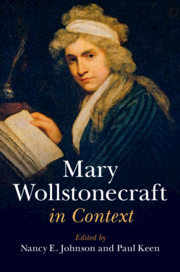Book contents
- Mary Wollstonecraft in Context
- Mary Wollstonecraft in Context
- Copyright page
- Contents
- Illustrations
- Notes on Contributors
- Preface
- Frontispiece
- Chronology
- Part I Life and Works
- Part II Critical Fortunes
- Part III Historical and Cultural Contexts
- The French Revolution Debate
- The Rights of Woman Debate
- Philosophical Frameworks
- Legal and Social Culture
- Literature
- Chapter 30 Sentimentalism and Sensibility
- Chapter 31 English Jacobin Novels
- Chapter 32 Anti-Jacobin Novels
- Chapter 33 Children’s Literature
- Chapter 34 Gothic Literature
- Chapter 35 Travel Writing
- Chapter 36 History Writing
- Chapter 37 Periodicals
- Chapter 38 Translations
- Suggested Further Reading
- Index
Chapter 31 - English Jacobin Novels
from Literature
Published online by Cambridge University Press: 16 January 2020
- Mary Wollstonecraft in Context
- Mary Wollstonecraft in Context
- Copyright page
- Contents
- Illustrations
- Notes on Contributors
- Preface
- Frontispiece
- Chronology
- Part I Life and Works
- Part II Critical Fortunes
- Part III Historical and Cultural Contexts
- The French Revolution Debate
- The Rights of Woman Debate
- Philosophical Frameworks
- Legal and Social Culture
- Literature
- Chapter 30 Sentimentalism and Sensibility
- Chapter 31 English Jacobin Novels
- Chapter 32 Anti-Jacobin Novels
- Chapter 33 Children’s Literature
- Chapter 34 Gothic Literature
- Chapter 35 Travel Writing
- Chapter 36 History Writing
- Chapter 37 Periodicals
- Chapter 38 Translations
- Suggested Further Reading
- Index
Summary
The first three volumes of Thomas Holcroft’s Hugh Trevor were published in 1794, the final three in 1797, the year of Mary Wollstonecraft’s death. This brief span marks the high point of what conservatives derogatively branded “Jacobin” fiction. While many of the heterodox ideas embraced by Holcroft were in circulation before the 1790s, they had been given fresh impetus by the paper war that followed Edmund Burke’s Reflections on the Revolution in France (1790). Reformist and radical critiques of what Wollstonecraft labeled Burke’s “rhetorical flourishes and infantine sensibility” drew sharp rejoinders from loyalists, initiating a spiraling debate that continued throughout the revolutionary decade.1 Key to the contention was the shared belief in an untapped audience susceptible to arguments for wide-scale change. Across the political spectrum, writers acted on their commitment to win adherents to their causes by exploiting the novel’s appeal to this emergent readership. Hugh Trevor testifies to the genre’s influence in its assessments of different print kinds and in the transformative energy sparked by the characters’ persuasive speech. The formal and thematic repertoire Holcroft deployed in his proselytizing efforts, including the reflexive interest in writing, matches with the practice of other novelists in the Godwin circle. In Mary: A Fiction (1788) and The Wrongs of Woman; or, Maria (1798), however, Wollstonecraft departs significantly from the standards of her male colleagues. Hugh Trevor helps to illuminate the points at which her compliance with Jacobin conventions yields to a different set of preoccupations, many of which she held in common with Utopian authors and with women writers such as Mary Hays, Elizabeth Inchbald, and Eliza Fenwick.
- Type
- Chapter
- Information
- Mary Wollstonecraft in Context , pp. 264 - 272Publisher: Cambridge University PressPrint publication year: 2020
- 1
- Cited by



